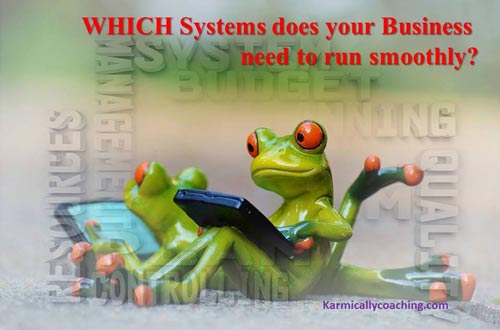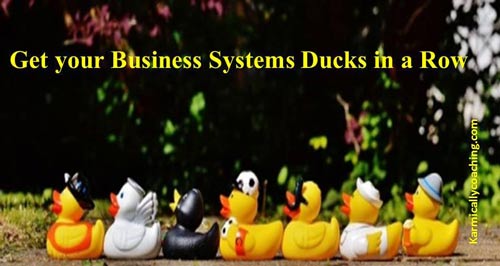
Every business, whether corporate, small home owned, sole proprietor or freelance needs systems. Even non-profit organizations have systems.
The only difference lies in the kinds and types of business systems that are appropriate to the level, complexity and size of the business. The systems that are set up are created to achieve the business goals of the entity in the most effective and efficient manner possible.
Without the right business systems, you’re running a chaotic outfit and would soon be out of business.
Your business is the vehicle for manifesting your Vision and Mission while earning a livelihood and taking your dream to the highest level that it can soar.
To run a viable venture, you need a business plan. You need to know how you’ll achieve the business objectives through the various back-end processes in order to deliver to your customers and get paid for your goods and services. You need to figure out the best way to market your business to reach your prospective niche market.
In other words, you need business systems and the right ones too.
A simple definition of business system is
“A methodical procedure or process that is used as a delivery mechanism for providing specific goods or services to customers.”
The fact that you may be a sole entrepreneur or a freelancer doesn’t allow you to pass the buck, thinking, you provide a service or a product, you get paid, you pay your taxes and that is that.
Quite often, as business owners, our focus is on generating revenue and profits, not on the systems that allow us to build our business on a strong foundation and provide a structure for future business development. To be profitable, there has to be structure for each major activity that we undertake for our business.
There’s a lot more going on in the back-end that has to run smoothly in order to present yourself as a serious player in the your niche and market.
For sure you have processes in place to take the customer experience from start to finish, the cradle to the grave. Many service providers often end up talking about this process to potential customers instead of sharing the benefits of the services.
You have processes and activities that involve blogging, creating videos, fabulous freebies, discovery sessions, client intakes, invoicing, tax submissions and whole lot more.
You tweak them, expand them and drop them depending upon how your business direction and needs develop.
So as you can see, Business processes are dynamic in nature, involve actions and keep evolving as our business services expand but they are part of a bigger whole – a business system.
A business can have more than 3 -4 business systems depending upon their activities and how those activities tie up with achieving the end goals of the business.
For example, let’s look at some activities and how they fit into a bigger picture.
Each of these activities is important to your business but they are only activities that belong to systems that are meant to help you achieve your business goal with efficiency and effectiveness as shown in the diagram below.

Which business systems are right for you?
That question really can’t be answered in a single blog post because there is a lot more to it, but there are 2 points you should consider to start getting your business system ducks in a row.

Type of business
Are you selling products or services or a mix?
What’s your business model? One on one or to many people at the same time?
A lot depends upon the nature of your business. If you are selling products then the kind of systems that you need will be different to the ones that a pure service provider will require.
For example, if you have stock, then your business systems would need to include inventory management and even cost management systems.
If you are providing a service, then having a good client intake system and client management system are going to be important. Especially if you want repeat business and happy client referrals instead of dishing out refunds or getting bad reviews on the internet.
Legal aspect of business
Will you be a sole proprietor or a company?
Will you need a license to practice?
Will you be providing goods or services in a regulated market?
Is your market local or global?
Will you need to register your business for service tax, VAT or other permits like export permits for your products?
Depending upon the way you have set up your business, you may need to register with different authorities, maintain additional books of accounts, get annual audits and file different tax returns.
In such a case, having a Compliance system will be important and the activities under this system would need to be taken care of either by you or by a delegated specialist.
Your Financial System would also need to be robust.
Ultimately, you know your business best. You are the best person to determine which systems you need and in what priority.
For example, when I first set up Karmic Ally Coaching, my first duck was to decide upon my legal entity and setting up the compliance and financial structure.
Then I set up my Sales and Marketing Systems and so forth. I didn’t need Inventory systems but later, I did need to enhance my Marketing System adding new activities and dropping others.
I even set up a special education system to monitor my own professional development!
Let’s Get your Business Systems Ducks in a Row

This exercise is going to help you to determine if there are any weak spots in your business that require attention, tweaking or need to have systems implemented. The exercise will take time but is worth the effort if you are looking to create a viable and sustainable business in the long run.
Step 1. Look at the various activities that you are presently undertaking in your business.
Step 2. Look at the following suggested business systems (in no particular order). Determine which of your activities come under which system. You may have some systems that I haven’t listed so do consider your existing systems too.
Legal and Compliance
Marketing
Sales
Material purchase
Financial
Administrative
Website Management
Client Management
Social Media Management
Products
Inventory
Product Development
Step 3. Assess your business systems. Are they meeting your business objectives? Are there some that you need but don’t have or have but don’t really need? Are any of your systems lopsided and deserve more attention?
In my next post, I’ll address business processes and creating an operations manual. Until then, I leave you with a question.
Which system do you need to work on in priority? Which ducks do you need to set in a row?



 I adhere to the Certified Coaches Alliance Code of Ethics and Standards. A copy is available on request.
I adhere to the Certified Coaches Alliance Code of Ethics and Standards. A copy is available on request.
 Let's Talk through the Connect Form:
Let's Talk through the Connect Form: